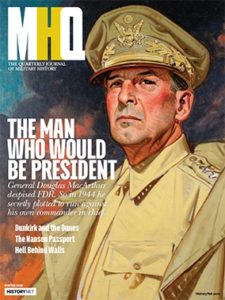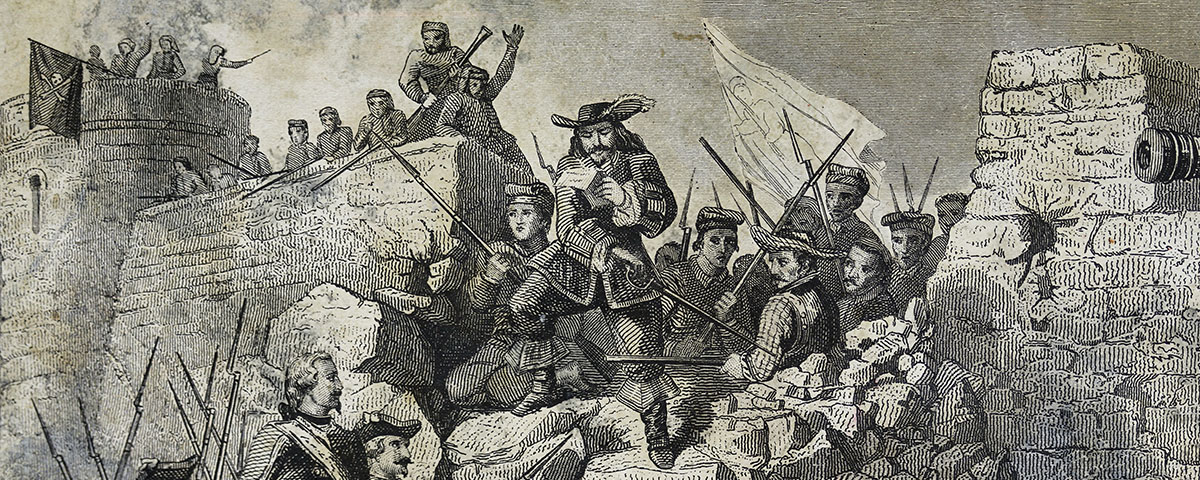The roots of Catalonia’s modern push for independence from Spain lie in struggles that stretch back hundreds of years.
TO CATALANS, 9/11 HAS A LONG HISTORY AS A DAY OF RECKONING. The Diada, or national day, commemorates the 1714 fall of Barcelona after a lengthy siege whose origins lie in the War of the Spanish Succession. In recent years the day has been linked to a new and growing conflict: Catalonia’s push for independence from Spain. The roots of that struggle lie even deeper in history, when Catalonia formed an essential part of the Kingdom of Aragon.
The making of Spain can be traced to 1469, when the marriage of Ferdinand of Aragon and Isabella of Castile politically unified their two kingdoms. By 1500 Aragon’s population totaled little more than a million people, while Castile’s was six times that. Gradually and predictably, Castile tried to dominate its smaller counterpart, and in 1640 Catalans staged a violent rebellion that became known as the Reapers War. Though the war was generally a peasant uprising against onerous taxes and Castile’s demand that its troops be billeted by locals, contemporary Catalans have reframed the narrative of the war as a revolt against Spain and celebrate it in their anthem, “Els Segadors”—“The Reapers.” Today’s separatists have embraced the anthem as their battle cry: “Catalonia triumphant shall again be rich and bountiful / Drive away these people / who are so conceited and so arrogant.”
IN SOME WAYS THE REAPERS WAR PRESAGED THE UNREST THAT WOULD ENGULF SPAIN In some ways the Reapers War in the early years of the 18th century. By then Spain had ceased to be a major power, and its weakness became apparent when Charles II died without an heir in 1700. Within months, the War of the Spanish Succession was on. Spain’s long Mediterranean coastline and access to the northern Atlantic made it an essential part of the wider European chessboard, and the continent’s two great powers, the Austrian Habsburgs and the French Bourbons, were each determined to seat their own candidate on the Spanish throne. A geopolitical struggle for European dominance, the war involved complex entanglements and shifting alliances, and it drew in kingdoms large and small. Spain itself split from west to east over support for the competing powers, with much of the Castile region backing the French Bourbon claimant, Philip V, grandson of Louis XIV, and the Aragon sector favoring the Habsburg, Charles, Archduke of Austria. The English, ever hostile to the French, allied with the Habsburgs and thus with Aragon.
The succession war raged across Europe for 13 years and cost an estimated 400,000 lives, though the wider web of conflicts it spawned may have taken double that number. A complicated series of treaties known as the Peace of Utrecht finally ended the war in 1713, placing Philip V on the Spanish throne. Britain, having gained important territorial and commercial concessions, quit the field. But Catalonia did not. Its discontent with Castile had smoldered since the Reapers War, but hostility to the French was also deeply rooted. With the larger war over, Catalonia stood alone against France and Bourbon Spain.
Catalonia’s position along the Pyrenees frontier with France and its Mediterranean coastline made it a strategic prize; adding to its appeal, Barcelona was a dynamic and wealthy city. Determined to control the area, the new Bourbon rulers of Spain mounted an offensive, planning to intimidate the Catalan countryside and isolate Barcelona. Some 85,000 troops were posted to the region, whose population totaled no more than half a million. Society struggled under military occupation, and brutal reprisals against the peasants resulted in hundreds of summary executions. But the harsh repression of the countryside only strengthened the resolve of Barcelona’s populace to resist. When city authorities agreed to capitulate to the Bourbons in June 1713, their decision was overturned under pressure from the guilds and the public.
As the Bourbons prepared to lay siege to the city, Antoni de Villaroel, who had a long and successful history as a military commander, first for the Bourbons and then for the Habsburgs, was entrusted with the organization of Barcelona’s defenses. Villaroel proved highly effective, despite having mustered only 6,000 to 7,000 men against the tens of thousands of besiegers. He focused his defensive strategy in three main areas: the countryside, the coastline, and the city’s medieval walls. In the countryside, the roughly 800 lightly armed combatants of the rural militia, or miquelets, began guerrilla operations, harrying Bourbon troops and disrupting supply lines. The miquelets’ knowledge of the mountainous terrain close to Barcelona gave them a clear advantage, and they proved a real menace to Bourbon forces.
Along the coast, Villaroel managed to keep open vital supply lines, thanks again to local knowledge of the area. Catalans found ways to slip through the enemy blockade, and for most of the first year of the siege, Barcelona’s citizens did not suffer great privation. The third element in Villaroel’s defensive plan, the city wall—three feet thick in most places—proved a strong bulwark against the Bourbon attackers. Repeated bombardment during the siege was largely ineffective. Barcelona’s militia, La Coronela, also played a key role. Organized in in six battalions, each representing a local tradesmen’s guild, it added significantly to the defense, and morale in the besieged city remained high.
The Duke of Pópoli, leading Castilians and French besiegers loyal to King Philip V, initially believed that the overwhelming show of Bourbon force would be enough to force the city to surrender, but it did not. Nor did repeated French-backed mortar barrages. After a year, Pópoli was nowhere near breaking the siege, though he had managed to advance to the outskirts of the city. For Louis XIV, France’s failure to take Barcelona was detrimental to the Bourbon reputation and could not be permitted in a Europe where perceived weakness invited attack. In July 1714 James FitzJames, 1st Duke of Berwick, replaced Pópoli, and French reinforcements arrived on the scene.
Berwick, the illegitimate son of the deposed James II of England, had emerged as a talented leader in the French army, and he had almost 40,000 men at his disposal when he took command. He planned a two-pronged approach to the siege. First, he wanted to effectively blockade the port, to prevent the arrival of provisions and war matériel and thus break civilian morale. Second, he aimed to breach the city’s medieval wall. To that end, armaments were trained on a specific section of the wall. In mid-July 84 large cannons and 24 mortars opened up in an almost uninterrupted bombardment of the targeted section. After a month, the bombardment had ripped only a small breach in the wall, and as French troops moved into the city, defenders attacked their flanks. Though casualties on both sides were heavy, the besiegers pressed forward, and with their marked advantage in numbers, they gradually made progress. Meanwhile, bombardment slowly created a larger opening in the wall.
The final assault began in the early morning of September 11, as 18,000 Bourbon troops poured into Barcelona. Though the city’s defenders were outnumbered three to one, they mounted an intense resistance. The last hours of the siege saw fierce hand-to-hand fighting, house by house, street by street, resulting in terrible destruction to the city. Estimates of the total losses among the Catalans range from 7,000 to 8,000 dead and wounded, while the besiegers lost more than 15,000 men. To prevent the loss of more of his men, Berwick accepted Barcelona’s offer of conditional surrender early in the afternoon of the 11th. One of the most remarkable sieges of the era had ended.
BERWICK HAD PROMISED TO PRESERVE THE PROPERTY AND WELFARE OF BARCELONA’S RESIDENTS, but Louis XIV did not honor his assurances. The French imprisoned some 20 military commanders from Barcelona, who forfeited their property, and began construction of La Ciutadella, an enormous military fortress overlooking the city. More than 6,000 troops were permanently stationed in Barcelona, with another 20,000 more remaining in Catalan territory. Inspired by the model of France, the Spanish Bourbon victors also began a process of centralization that included the repression of the region’s linguistic and cultural heritage. The traditional rights and privileges that Catalonia and the wider territories of the former Kingdom of Aragon had maintained since the Middle Ages were abolished.
Despite the repression, by the late 18th century Catalonia had become the first area of Spain to industrialize, spurring an economic revival. By 1790 Catalan cotton production was second only to Britain’s; the textile industry would continue to play a fundamental role in the region’s economic regeneration throughout the next century. During that period Catalonia remained loyal to Spain, even as a Catalan cultural renaissance gained momentum, and the 1714 siege of Barcelona came to play a prominent role in the region’s self-narrative.
In 1932 a statute for Catalan autonomy became law, but seven years later the Nationalists’ bloody victory in the Spanish Civil War brought an end to that. Generalissimo Francisco Franco’s fascist regime was intent on building a new and glorious Spain, where regional languages and traditions would have no place. Linguistic and cultural repression again ensued but could not suppress the Catalan spirit. On September 11, 1976, the year after Franco’s death, some 100,000 people demonstrated for Catalan autonomy in the town of Sant Boi, outside Barcelona, because authorities had refused to allow them to gather in the city.
The following September 11, however, a million people marched in Barcelona, demanding, among other things, the restoration of a regional Catalan government, or Generalitat—one of the institutions abolished after the 1714 defeat of Barcelona. In 2006 Catalonia achieved “nation” status, but that status was rescinded four years later. Today, as Catalan leaders are imprisoned or flee to avoid punishment and the separatist movement grows, Europe once more worries that the fate of Spain could have repercussions across the continent, and some Catalonians feel that Barcelona is under siege once again. MHQ
Andrew Dowling, a senior lecturer in Hispanic studies at Cardiff University, is the author of The Rise of Catalan Independence: Spain’s Territorial Crisis (Routledge, 2012).
[hr]
This article appears in the Winter 2019 issue (Vol. 31, No. 2) of MHQ—The Quarterly Journal of Military History with the headline: Catalonia’s 9/11


